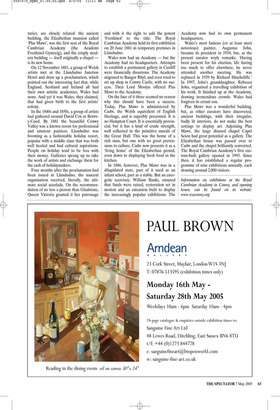Welsh legacy
Russell Chamberlin
Conwy in north Wales is among the most enchanting of our small towns. It’s like a toy fort, its encircling walls surviving intact until Thomas Telford had to breach them for his bridge. He did it elegantly, even delicately, creating a suspension bridge that actually enhanced the little town. It was for our brutal, automanic age to bulldoze through a road bridge in an act of architectural rape.
But that apart, the town is a gem. Within the encircling walls there is a medley of little twisting lanes that give the impression of being in a far larger town, for the visitor is never quite certain where the lanes are leading. One of these is Crown Lane. Rather steep. Very narrow. On the lefthand side as you go up it is a massive wall with a few windows — all evidently of great age but withdrawn, enigmatic. In the past, the town’s grandees, finding themselves living in proximity to the mob, were unwilling to run open house. Immediately adjoining this forbidding mansion is a crisply modern frontage, all plate-glass and woodwork, but somehow companionable.
The two buildings, separated by cen turies, are closely related: the ancient building, the Elizabethan mansion called ‘Plas Mawr’, was the first seat of the Royal Cambrian Academy (the Academi Frenhinol Gymreig), and the crisply modern building — itself originally a chapel is its new home.
On 12 November 1881, a group of Welsh artists met at the Llandudno Junction Hotel and drew up a proclamation, which pointed out the interesting fact that, while England, Scotland and Ireland all had their own artistic academies, Wales had none. And yet it was Wales, they claimed, that had given birth to the first artists’ colony.
In the 1840s and 1850s, a group of artists had gathered around David Cox at Betwsy-Coed. By 1881 the beautiful Conwy Valley was a known resort for professional and amateur painters. Llandudno was booming as a fashionable holiday resort, popular with a middle class that was both well heeled and had cultural aspirations. People on holiday tend to be free with their money. Galleries sprang up to take the work of artists and exchange them for the cash of holidaymakers.
Four months after the proclamation had been issued in Llandudno, the nascent organisation received, literally, the ultimate social accolade. On the recommendation of no less a person than Gladstone, Queen Victoria granted it her patronage and with it the right to add the potent ‘Frenhinol’ to the title. The Royal Cambrian Academy held its first exhibition on 20 June 1881 in temporary premises in Llandudno.
Wales now had an Academy — but the Academy had no headquarters. Attempts to establish a permanent gallery in Cardiff were financially disastrous. The Academy migrated to Bangor Rhyl, and even tried to set up shop in Conwy Castle, with no success. Then Lord Mostyn offered Plas Mawr to the Academy.
On the face of it there seemed no reason why this should have been a success. Today, Plas Mawr is administered by Cadw, the Welsh equivalent of English Heritage, and is superbly presented. It is no Hampton Court. It is essentially provincial, but it has a kind of crude strength, well reflected in the primitive murals of the Great Hall. This was the home of a rich man, but one with no great pretensions to culture. Cadw now presents it as a ‘living home’ of the Elizabethan period, even down to displaying fresh food in the kitchen.
In 1886, however, Plas Mawr was in a dilapidated state, part of it used as an infant school, part as a stable. But an energetic secretary, William Banks, ensured that funds were raised, restoration set in motion and an extension built to display the increasingly popular exhibitions. The Academy now had its own permanent headquarters.
Wales’s most famous (or at least most notorious) painter, Augustus John, became its president in 1934, but, as the present curator wryly remarks, ‘Having been present for his election, life having too much to offer elsewhere, he never attended another meeting. He was replaced in 1939 by Richard Hinchcliffe.’ In 1997, John’s granddaughter, Rebecca John, organised a travelling exhibition of his work. It finished up at the Academy, drawing tremendous crowds. Wales had forgiven its errant son.
Plas Mawr was a wonderful building, but, as other curators have discovered, ancient buildings, with their irregular, badly lit interiors, do not make the best settings to display art. Adjoining Plas Mawr, the large disused chapel Capel Seion had great potential as a gallery. The Elizabethan house was passed over to Cadw and the chapel brilliantly converted. The Royal Cambrian Academy’s first custom-built gallery opened in 1993. Since then, it has established a regular programme of nine exhibitions annually, each drawing around 2,000 visitors.
Information on exhibitions at the Royal Cambrian Academy in Conwy, and opening hours, can be found on its website: www.rcaconwy.org




























































 Previous page
Previous page